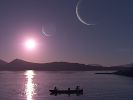Eye For Film >> Movies >> The Pearl Button (2015) Film Review
The Pearl Button
Reviewed by: Amber Wilkinson

Water imagery and a warmth of spirit flow through Patricio Guzmán's The Pearl Button even when he is tackling the horrors of genocide or the fate of supporters of President Allende who "disappeared" under the rule of Augusto Pinchoet. He begins his film with a drop of water caught in a block of Quartz some 3000 years ago, the tiny piece of ancient history moving yet trapped forever - and this sense of adaptability, movement and repetition reverberate through the film.
The tribal peoples of Western Patagonia, an archipelago of islands and fjords with around 46,000 miles of coastline, believed that all objects - including water - have a spirit and Guzmán considers this along with our place in the cosmos. The director takes a poetic approach, moving seamlessly from the wash and rhythm of waves to the balletic otherworldly synchronicity of scanners in the Atacama desert that turn simultaneously to look to the skies. Elsewhere, we become mesmerised by the glint and sparkle of light dancing to the movement of dark water and watch as the scene fades into a galaxy of stars.

Guzmán goes on to suggest that even the universe of Chile goes largely unappreciated by its modern natives, who despite water flowing from the toe to the tip of the country, would rather look inward to the land than out to the sea. However, this was not the case for the five indigenous tribes who originally made their home there, so comfortable in canoes that they lit fires at their centre and thought nothing of paddling for days on end with their children in tow. But despite the fact that they were able to adapt to the harsh environment of the archipelago, with its winds gusting up to more than 100 miles an hour and its weather patterns unpredictable, colonialism brought with it problems that were insurmountable - chiefly, diseases they were unable to resist and animosity that they couldn't possibly have seen coming.
Today, only around 20 of the descendants of these 8000-strong tribes survive, cherishing a culture and dying languages that even they are seen struggling to remember. The film's emotional heart beats strongest in the scenes where one woman recalls a trip she made as a child in Kawesqar, the clicking unfamiliarity of her language seeming a perfect match for the unpredictability of the Pacific and, later, offers translations of words on cue, pausing at the word God to say, "Not God, we don't have that". The Button of the title holds a two-fold meaning. Firstly, it represents the price that was paid to (or for) tribesman Jemmy Button by British sea captain Robert Fitzroy, who was intent on taking him back to 'civilise' him. As Guzmán puts it, in a theme that recalls his previous film Nostalgia For The Light, when Button returned to Chile he became "a time traveller in his own lifetime". The second button represents another crime as Guzmán considers the fate of those Disappeared who were sent to a watery grave.
Looking at all these themes on paper, there is no way they should be able to co-exist within the same film, let alone do so in harmony, but Guzmán lets each wave of thought flow over the other, tributaries of history gathering to a ocean of argument that carries you with it at once transfixed by the beauties of the cosmos and the horrors of man's inhumanities to man.
Reviewed on: 10 Feb 2015















